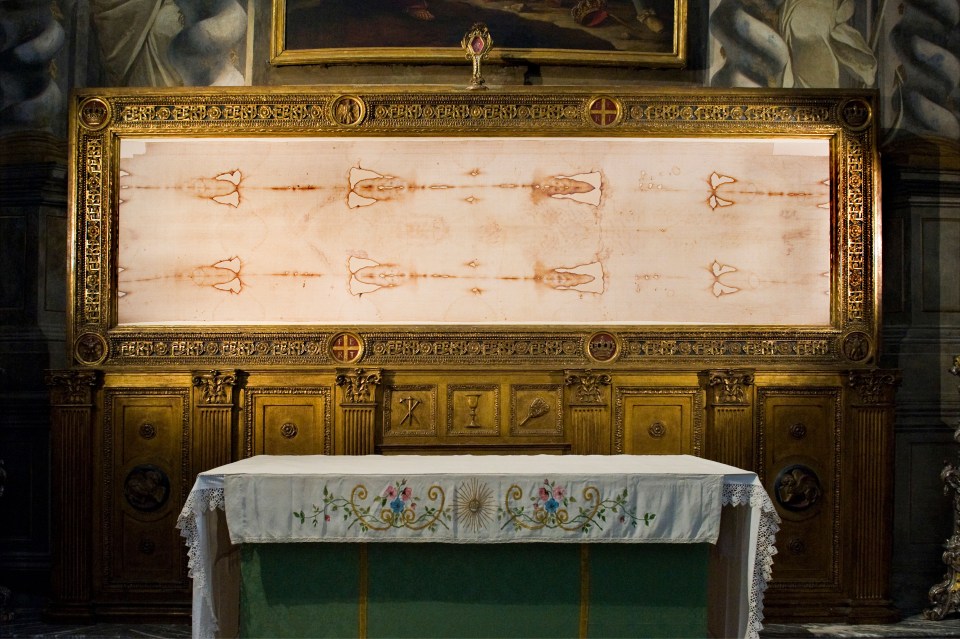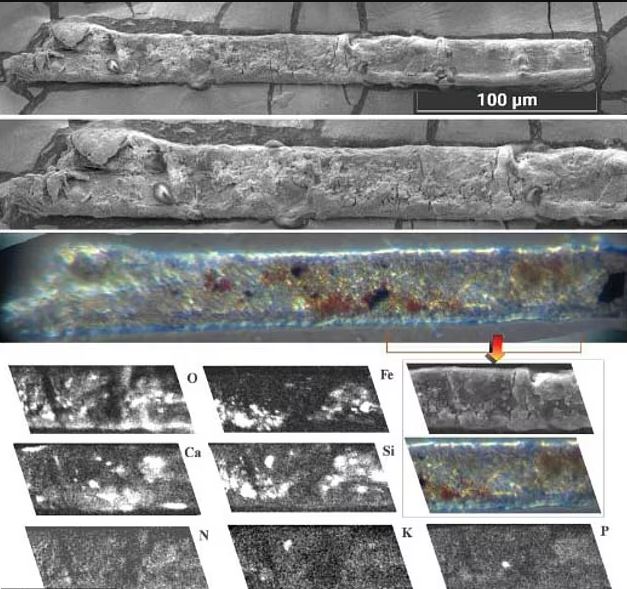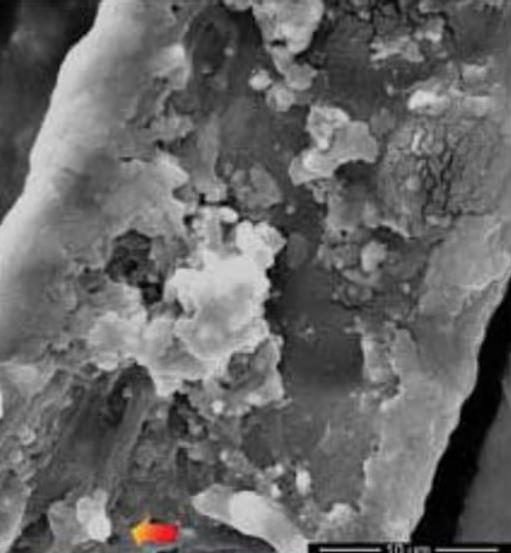THE sacred Shroud of Turin could be in fact real and may have been kept hidden in plain sight by early Christians, a bombshell book has claimed.
The ancient piece of linen cloth claims to show an imprint of Christ – and some believe it was wrapped around his body for burial after he was crucified in a bloody execution.
This millennium-long gap in the Shroud’s early history has often been cited by sceptics as proof of fraud.
But a thought-provoking book now argues that the Shroud was first hidden for a legitimate reason and that the enigmatic cloth might actually be an actual relic from the Passion of the Christ.
The Hidden History of the Shroud of Turin was written by American attorney and author Jack Markwardt.
FEAR OF PERSECUTION
In it, Markwardt describes the historically proven habit of early Christians hiding their faith from fear of persecution, which is known in Latin as Disciplina arcani, or the “Discipline of the Secret.”
More on the Shroud of Turin
It was common in the fourth and fifth centuries for the early Church to keep some beliefs hidden from persecutors and even from those who were only beginning to explore their faith.
Markwardt argues that the principles of Disciplina arcani would have somehow forced nascent Christian church to therefore conceal Shroud’s existence.
He writes: “When, shortly after Jesus’ death, his disciples, now organised as a Church, were confronted with religious persecution.
“They obeyed his directives by resorting to secrecy and concealing, from non-believers, every pearl of the new faith, including the Turin Shroud.”
Although the Shroud was kept hidden, Markwardt claims that references to a very similar relic can be discovered in a number of ancient sources – suggesting that its whereabouts and care were known during this time of extreme secrecy.
According to the author and lawyer, St. Peter brought the Shroud with him when he travelled to Antioch, an ancient Greek city on the Orontes River that is now part of Turkey and had a legendary role in the Crusades.
From there, the Shroud is thought to have wound up once again hidden – this time above the Cherubin Gate, higher up in Antioch’s walls.
Markwardt uses the apocryphal “Gospel of the Hebrews” as proof, whereby it is said that “the Lord” gave “the linen cloth to the servant of the priest.”
Strangely, during the time Markwardt says the Shroud was concealed behind Antioch’s walls, the bearded image on the fabric started to appear in paintings of Jesus, who was previously portrayed as a young man with no beard.
Across Christian artworks from the third to fifth century, Jesus is then depicted as a bearded man.
HIDDEN IN PLAIN SIGHT
Meanwhile, author Ian Wilson suggests that writing from the time referring to the “Image of Edessa” might have been the Shroud itself, folded four times and displayed as the only representation of Christ’s face.
According to legend, the image of Edessa originated with King Abgar of Edessa, who lived in what is now Turkey’s Urfa and asked Jesus to heal him of a disease.
“Four texts and a work of art confirm that Pope Eleutherius, upon receiving [King] Abgar the Great’s request to become a Christian,” Markwardt writes, not only “effectuated his baptism” but “directed that the Turin Shroud be displayed to him.”
The book claims that the Catholic Pontiff hoped ‘to affirm him in his decision to be baptised,’ thereby bolstering the king’s belief in his conversion.’
According to a more romanticised version examined by the National Catholic Register, one of King Abgar’s more recent predecessors had begged the still-living Jesus to come heal him by performing one of his miracles.
In this mythology, Jesus declined but instead wrote a letter in which a picture of himself appeared, which according to different sources was either painted or “made by God.”
Even more reports suggest that the Shroud was circulated and on exhibit in the area in the decades and centuries that followed the historically documented date of Christ’s crucifixion.
A portrait of the Lord Jesus Christ “painted on a tablet of boards [that] contained the image of our Lord and Saviour at full length” is mentioned in the Sermon of Athanasius, which is supposedly authored by an Alexandrian bishop in the fourth century.
In his book, Markwardt argues: “The Shroud is the only full-length ‘holy image of our Lord and Savior’ associated with Jesus’ Passion even putatively datable to that time.
“Assuming that this text is truly authentic and reliable, it is clearly connected with the flight of the Church of Jerusalem.
He continues: “It is incumbent upon those who would claim that, at that time, the Turin Shroud either did not exist or was concealed to identify a full-length ‘holy image of our Lord and Savior’ associated with Jesus’ Passion, other than the Turin Shroud, to which the Sermon of Athanasius could possibly refer.”
THE SHROUD’S ORIGINS
According to Markwardt, a significant portion of the uncertainty about the origins of the Shroud might have originated from tales told by Justinian I in an attempt by the Eastern Roman emperor to get the Shroud for himself.
According to the lawyer, Justinian purposefully disseminated a legend about a face image of Jesus that came from the little Cappadocian settlement of Camulania.
This myth provided ammunition for those who wished to dispute the Shroud’s historic origin.
The author writes: “By creating the illusion […] the emperor Justinian I effectively, and forever, obliterated the relic’s apostolic provenance, its entire ancient history, and its five-centuries-long affiliation with the Church of Antioch.
“This covetous, rapacious, and scheming Byzantine emperor, more than any other person, is responsible for the historical obscurity which presently surrounds the Turin Shroud [and] the doubt which presently surrounds its authenticity.”
CALLS FOR ANALYSIS
Scientists previously called for more expert analysis of the mysterious Shroud of Turin amid swirling evidence it backs up the Bible story of Jesus’ crucifixion.
A fresh review by researchers from France and Italy took another look at those findings, and have claimed there are discrepancies in the data that weren’t made public.
The shroud first shown to the public as far back as 1350.
A 1988 study deployed a technique called carbon dating, hoping to determine the true age of the cloth after claims it could be a result of medieval forgery.
Researchers found with “95 percent confidence” that it was made between 1260 and 1390 AD.
That would be many generations after Christ’s death, which is believed to have occurred in 33 AD.
To arrive at those conclusions, researchers from the Universities of Arizona, Zurich, and Oxford collaborated to examine a section of cloth.
But independent French researcher Tristan Casabianca stated that the results differed between labs, casting doubt on the findings.
He told the Daily Mail a Zürich estimate said the cloth was up to 733 years old, but 595 years in the raw data.
Oxford’s sample ranged between 730 and 795 years old, but the raw data had estimations that were up to 55 years off.
According to Casabianca, Arizona dated the linen between 591 and 701 years ago, with a variance of up to 59 years in their raw data.
Even with the flaws, the cloth is still positioned in the Middle Ages.
However, Casabianca maintains that this casts doubt on the conclusions.
It’s led to calls for further investigation into the cloth, and comes after a Christian researcher claimed to find traces of blood on it – saying it backs up the story of Jesus’ bloody execution.
BLOOD ON THE SHROUD
It is understood that Jesus was crucified with nails in his hands and feet.
But Giulio Fanti, an engineer from the University of Padua, reanalysed shroud samples from the 1970s and discovered blood particles and ancient Jerusalem-specific material.
According to the professor, this shows that the cloth originated in the region, which corresponds to the New Testament story of Jesus being crucified on the hills just outside Jerusalem’s walls.
Independent experts were quick to point out that the cloth may have been polluted with blood at any time during the hundreds of years after it was first displayed to the public in the 1350s.
But the study was nonetheless published in the peer-reviewed Archives of Hematology Case Reports and Reviews
Fanti says he found hemoglobin, the protein in red blood cells that carries oxygen, along with two different types of blood.
He claims his findings indicate the shroud was used on someone with wounds and gashes.
Fanti says this proves it wasn’t forged with paint, dye, ink or another technique.









